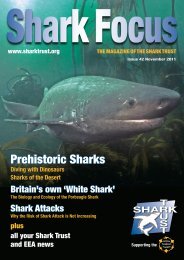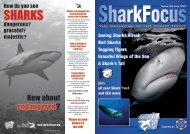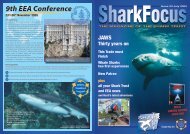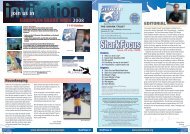Shark Focus
here - The Shark Trust
here - The Shark Trust
You also want an ePaper? Increase the reach of your titles
YUMPU automatically turns print PDFs into web optimized ePapers that Google loves.
Freshwater elasmobranchs:why so few Species?DistributionFreshwater elasmobranchs are found exclusively in subtropicaland tropical rivers and lakes, where prolonged isolation has ledto speciation and specialisation to freshwater habitats.The obligate freshwater South American stingrays [seeglossary] belonging to the family Potamotrygonidae have beenisolated in freshwater for the longest (approximately 25 millionyears) and are consequently the best suited to freshwater– as well as being the most diverse group of freshwaterelasmobranchs (with 30+ species). These are the beautifulstingrays highly prized in the tropical fish trade (image 2), andalthough increasingly difficult to obtain from South Americadue to protective legislation, many of these species are nowraised in Southeast Asia to supply the pet trade.The obligate freshwater species native to Southeast Asia arethe whiprays and include the White-edge Freshwater WhiprayHimantura signifier (image 3) and the Freshwater Whipray H.chaophraya (image 4), often seen and eaten in wet marketsin Thailand – with the latter being the largest freshwater fishin the world. Despite this, the biology of these species remainspoorly understood.The few species of euryhaline elasmobranchs aredistributed more globally. Perhaps the most well-known is theBull <strong>Shark</strong> Carcharhinus leucas which has been recorded fromNorth and South America, Africa, the Middle East, Australiaand Asia and is capable of living for years in either fresh orsaltwater – although they are not capable of completing theirreproductive cycle in freshwater.Like Potamotrygonidae, sawfish belonging to the familyPristidae are well adapted to freshwater. A couple of speciesof sawfish (Pristis microdon and P. perotteti – image 5) havebeen documented living in freshwater in Australia, SoutheastAsia, as well as in Central and South America. Further north,the Atlantic Stingray Dasyatis sabina is also capable of livingin fresh or saltwater. In fact, permanent populations ofD. sabina are found in the St. Johns River system in Florida,USA, making D. sabina the only freshwater elasmobranchnative to North America (image 6). Interestingly, D. sabina mayalso be the only elasmobranch species capable of reproducingin both freshwater and saltwater.EvolutionThe ability to live in freshwater has evolvedseveral times. Indeed, in the past, when theearth was considerably warmer, freshwaterelasmobranchs were much more common. Themajority of freshwater species are batoids (rays,skates and sawfish) with estimates placing~84% of species known to enter freshwater inthe stingray order Myliobatiformes 3 . Within theMyliobatiform group two families, Dasyatidae andPotamotrygonidae, account for 30% and 52%of all freshwater species respectively. Only 10%of shark species can tolerate excursions intofreshwater and many of these can only toleratefreshwater for short periods.Main image: One of the few euryhaline species, theBull <strong>Shark</strong> Carcharhinus leucas. © Albert Kok.Image 2: Ocellate River Stingray Potamotrygonmotoro. © Steven G. Johnson.Image 3: White-edge Freshwater Whipray Himanturasignifer and other fish species at a wet market inThailand. © Dr James S. Ballantyne.David I. Fraser and James S. BallantyneDepartment of Integrative Biology –University of Guelph, Ontario, CanadaElasmobranchs (sharks, skates and rays)are usually viewed as strictly marine buta few species, less than 5%, actually livein freshwater 1 . Even fewer, just five-tosixspecies, can live in both marine andfreshwater environments 2 , and are known aseuryhaline species. The focus of this articlewill be the challenges, constraints andadaptations of elasmobranchs in freshwater.23OsmoregulationOne of the main problems with living in freshwater is theosmotic difference with seawater. Marine elasmobranchsare osmoconformers, exhibiting a similar osmotic pressurein their body fluids as the environment in which they live.This osmotic pressure is largely due to the accumulationof urea; when elasmobranchs move into freshwater theyneed to reduce their internal osmotic pressure to minimizewater uptake. The two general means by which urea levelscan be altered in elasmobranchs are through changesto urea biosynthesis and urea excretion. As part of this,the Ornithine urea cycle – the major pathway by whichelasmobranchs produce urea – is greatly reduced inobligate freshwater species.Other species, such as D. sabina, increase the volumeof urine excreted, with urea being a major componentof the urine. Unfortunately, some – perhaps many –elasmobranch proteins require urea for optimal function,so adapting to freshwater is difficult for many species.Only the South American stingrays have managed toeliminate the need for urea. In fact, they have entirelylost the capacity to make large amounts of urea,preventing them from living in seawater.In seawater, elasmobranchs excrete the largeamounts of salt entering their bodies with a specialisedgland called the rectal gland. This gland produces asalt-rich fluid that enters the rectum and is voided.In freshwater, the low salt content of the environmentmakes the rectal gland of little use and it is substantiallyreduced in size in obligate freshwater species. Euryhalinespecies need to keep a functional rectal gland even infreshwater for when they return to seawater.The kidneys of marine elasmobranchs are complexwith many loops thought to help in the recovery of ureafrom the urine. In the exclusively freshwater SouthAmerican stingrays the kidney is much simpler, as fewerloops are needed for urea recovery. This anatomicalchange also prevents this group from living in seawater.Sensory BiologyAnother problem with changing from seawater tofreshwater involves one of an elasmobranch’s mostimportant senses: its electrosensing organs, theampullae of Lorenzini, must adapt to the differentconductivity of seawater and freshwater. The conductivityof seawater is much greater than that of freshwater sothe capacity to use this sense in freshwater is reduced.One adaption exhibited by freshwater species studiedto-date is the placement of ampullae much closer tothe surface of the skin to improve reception. It maybe difficult or impossible to change the structure ofthe ampullae when moving between freshwater andseawater.4ReproductionReproduction in freshwater is also an obstacle for manyelasmobranchs. Many marine elasmobranchs lay eggs(mermaid’s purses) which are highly permeable. Inseawater the osmotic gradient is not large enough tobe a problem for the embryo. In freshwater, however,the gradient is very large and would require significantenergy expenditure from the embryo to maintainosmotic pressure. Perhaps because of this problem, allfreshwater elasmobranchs give birth to live young withthe mother dealing with the salinity problems in the earlyembryonic stages.Another reproductive problem is the mechanismelasmobranchs use for sperm transfer. Allelasmobranchs use internal fertilization and some usesiphon sacs filled with seawater to flush sperm into theuterus of the female. <strong>Shark</strong> sperm suffers from the sameproblem as embryos in dealing with the large osmoticdifference with freshwater. The only elasmobranchs tosuccessfully reproduce in freshwater are batoids that donot use ambient water to flush sperm into the female.Thus there are numerous physiological problems forelasmobranchs entering freshwater; for a more detailedphysiological analysis of obligate freshwater species seeBallantyne and Robinson (2010) 4 , and for euryhalinespecies see Ballantyne and Fraser (2013) 2 .ConclusionCompared to other groups of fishes, freshwaterexcursions are relatively rare in extant elasmobranchs.The reasons for this span all aspects of elasmobranchphysiology, including sensory biology, reproduction andosmoregulation. Despite this, some species can tolerateand even thrive in freshwater, with greater physiologicalstudy required to fully understand the unique biology offreshwater elasmobranchs.Image 4: Freshwater Whipray Himantura chaophraya© FishSiam.Image 5: Freshwater Pristis sp. at a tropical fish supplier inSoutheast Asia. © Dr James S. Ballantyne.Image 6: Atlantic Stingray Dasyatis sabina. © NOAA.6GlossaryEuryhaline species: can live in both marine and freshwaterenvironments.Obligate freshwater species: found only in freshwater,incapable of adapting to saltwater.Osmoconformers: species which maintain internal salinity sothat it is always equal to surrounding seawater.Osmotic pressure: the pressure which needs to be appliedto a solution to prevent the inward flow of water across asemipermeable membrane (i.e. skin).Biosynthesis: the formation of chemical compounds by a livingorganism.Ornithine urea cycle: a cycle of biochemical reactionsoccurring in many animals that produces urea from ammonia.Organisms that cannot quickly remove ammonia must convert itto another substance, like urea, which is much less toxic.Ampullae of Lorenzini: a network of jelly-filled pores whichdetect electric fields in water.Extant: a term referring to species, genera and families that arestill in existence (as opposed to extinct)References1. Helfman, G.S., Collete, B.B., and Facey, D.E. (1997). Malden, MA:Blackwell Science.2. Ballatyne, J.S., and D.I. Fraser. (2013). New York, NY: Academic Press.3. Martin, R.A. (2005). J. Mar. Biol. Assoc. UK. 85: 1049-1073.4. Ballantyne, J.S., and J.W. Robinson. (2010). J. Comp. Physiol. 180B:475–493.54 www.sharktrust.org/s&rmorphology <strong>Shark</strong> <strong>Focus</strong> 46<strong>Shark</strong> <strong>Focus</strong> 46 www.sharktrust.org/s&rmorphology 5
















